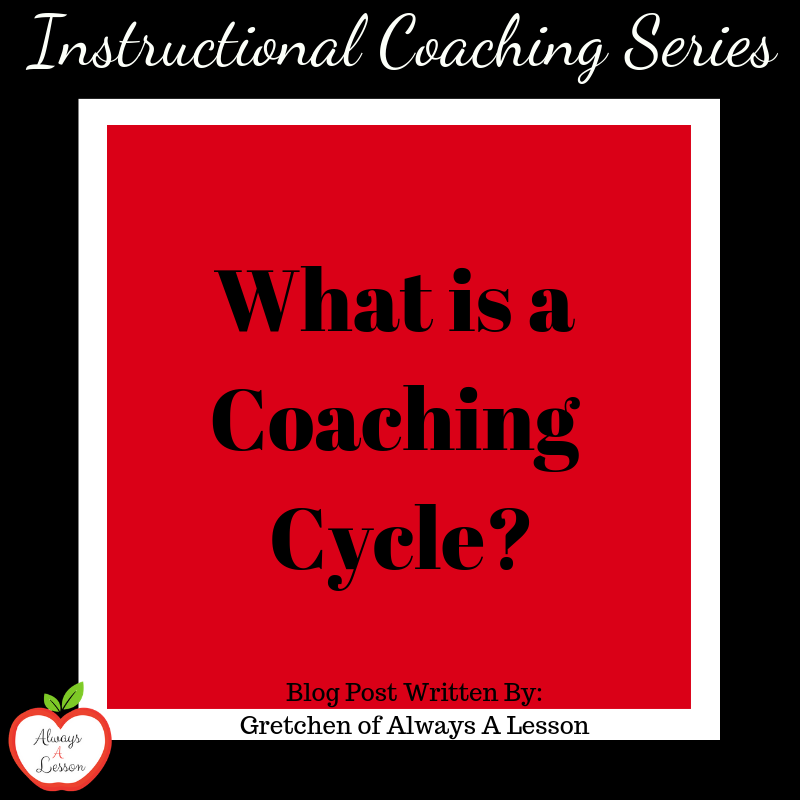Coaching Cycle- What is it and How Do I Conduct One?
A coaching cycle puts a framework in place to ensure teachers are improving in the classroom so that students can too. If you are new to the role of an instructional coach or want more clarity on what you could be doing to better help teachers, this blog post will outline how to successfully set up a coaching cycle at your site.
What is a Coaching Cycle?
The term ‘coaching cycle’ refers to a continuous series of steps an instructional coach follows when working with teachers to improve their proficiency in the classroom. Instead of a linear set of steps, a coaching cycle is circular. This allows for a repetition of these steps so that the teacher gains the skills necessary to be successful on their own.
What Duties are Included in a Coaching Cycle?
Duties included in a coaching cycle vary based on the needs of a school district, school building, and teaching staff. However, most coaching cycles include a task list such as: goal setting meeting, pre-observation, observation, post-observation, professional development opportunities, reflection discussions, and rounds of practice.
Want a coaching cycle visual? Snag it here.
How Do I Set-Up a Coaching Cycle?
The following steps will ensure your coaching cycle is accurate for the work you’re expected to do for and with teachers. It will also bring clarity to the purpose of the work you as the coach will be doing to enhance teacher skillsets.
Get clear on your purpose as an instructional coach.
This might require you to meet with your school’s principal to establish a set of goals that your support will address. The tasks you complete as a coach will stem from these goals. A coaching cycle will allow you to work closely with teachers on specific skills to address these goals. However, the specific skills must be prioritized based on how they relate to the school’s goal. Otherwise, you will be working with teachers on random skills that will not move them towards meeting the school goal.
For example, a school who’s goal is to implement a 1:1 iPad initiative would prioritize teaching skills that promote the growth of teacher proficiency in using iPads for instructional purposes, such as personalized learning and student ownership.
Know who you are working with and where they fall on a teaching proficiency continuum.
The coaching cycle is set up for teachers with varying levels of proficiency to receive the corresponding level of support from a coach. That means you need to know who you are supporting so that you can successfully match your level of support to teacher proficiency in the focus skills.
For example, it might be helpful to meet with your principal one-on-one with a teacher roster and rank teacher proficiency in the focus skills. Maybe you use a scale of 1-5, one being novice and five being masterful. Now you can easily group teachers based on intensity of support and insert them into the coaching cycle where applicable. Notice that teachers ranking at a level 1 will need numerous cycles of support each quarter where level 5 teachers might benefit from only one cycle of support per quarter.
Establish a relationship with and vision for teachers and their development.
Teachers need to know that you are there to help them as a colleague, not an evaluator. They also need to have a clear vision of where the relationship with you will go throughout the school year. This is a good time to share school goals, personal teacher goals, and ways you plan to work together. Sharing the coaching cycle plan and walking teachers through what it looks like on paper before diving into the work breeds clarity and transparency- a strong recipe for a successful relationship built on trust.
How Do I Conduct a Coaching Cycle?
Now that you know what your role is, what your focus is and who you are working with, it is time to put your teacher development framework into action!
As you meet with teachers and see their instruction live, you will be able to gather more data into their progression towards school goals. You can design professional development sessions and practice opportunities for teachers to fine tune their skills. As teachers consistently demonstrate proficiency, they can exit your coaching cycle and return after a period of time for a check-in.
*TIP* Teachers will be moving through your stages of support and even demonstrating varying degrees of proficiency depending on the skill focus so it could get messy and confusing. I highly suggest using pencil or sticky notes with teacher names on your coaching cycle visual. [If you need a coaching cycle visual, click here.]
Coaching cycles are the bread and butter of instructional coaching. Be sure to take the proper time to set them up correctly so that all stakeholders benefit. If you need personalized help setting them up, shoot me an email at [email protected]. Also, if you are in need of coaching forms to use in your coaching cycle, snag my bundle of coaching forms here at a discount! Or do you prefer to gain research-based techniques and tools to boost teacher performance and proficiency? Watch the webinar here.
Continue reading blog posts from the Instructional Coaching Series here:
- Preparing the behind-the-scenes tasks of an instructional coach
- Conducting a classroom observation with clarity and precision
- Providing models of expert teaching through coaching
- How to set up your instructional coaching space
- How to transition from a teaching role into a coaching role
GO BE GREAT!
How do you implement coaching cycles at your school?


